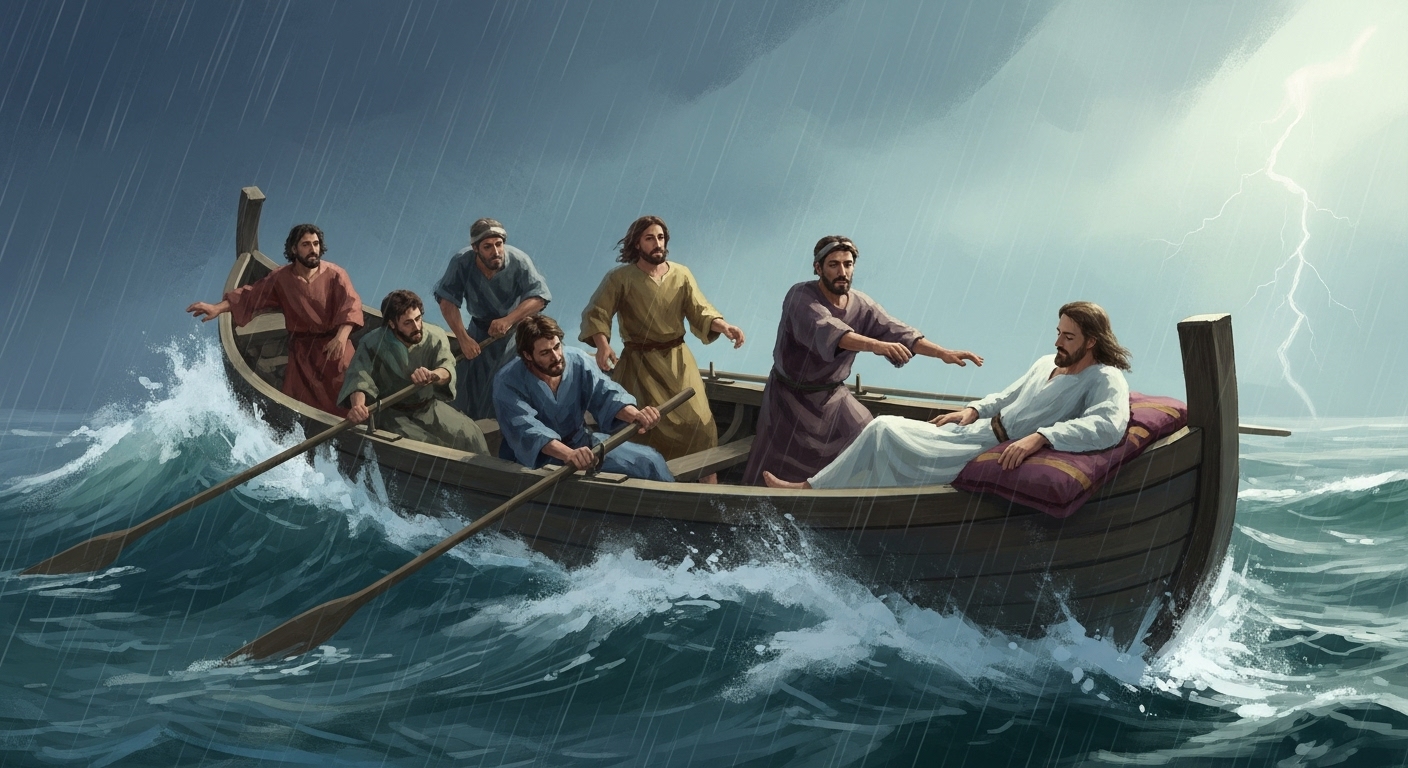The Promise Of Peace In The Middle Of The Storm

You’ve probably been there: the sky darkens, the wind picks up, and plans that felt steady start to wobble. Whether your storm is literal or the kind that shows up in the middle of a busy life, the ache is the same — you want rest, relief, an anchor. The ancient story in Mark 4:35-41 is written for you. It’s not simply about a historical miracle; it’s about the promise of peace in the storm, an invitation to discover how Christ’s presence transforms chaos into calm.
Mark’s account places you in a small boat with exhausted followers, a terrifying squall, and a sleeping Lord. When Jesus wakes and speaks, everything changes. As you read this, you’ll walk slowly through the narrative, unpack the meaning of “peace in the storm,” connect it to other biblical promises, and gather practical ways to rely on his calming presence when your world feels unmoored. If you want clarity, hope, and something immediate to do when fear rises, this is written for you.
The Sea of Galilee: Your Unexpected Storm
When Mark tells you that Jesus and his disciples crossed to the other side, he gives you a setting that feels ordinary at first — a lake crossing, evening coming on. But ordinary settings are often where storms show up. The Sea of Galilee was notorious for sudden squalls that could turn a calm evening into a fight for survival. Mark 4:35-41 captures that shift into chaos and the disciples’ human response: panic. Read the passage for yourself: Mark 4:35-41.
You, like the disciples, can be blindsided when circumstances change faster than you can adapt. One moment you’re rowing; the next, the waves are in the boat. Mark’s detail about Jesus sleeping on a cushion shows that his rest was not a passive indifference — rather, it was rooted in trust and authority. This contrast prepares you to understand a central claim: Christ’s presence is not removed by the storm; his authority over it is intact.

The disciples’ fear and your fear
When the disciples woke Jesus, they didn’t come with a theological argument or a plan; they came with raw fear. Their cry, “Teacher, don’t you care if we drown?” (see Mark 4:38) shows how easily fear shifts the way you see God: from protector to bystander. In the middle of personal storms — loss, job insecurity, health crises, relational breakdown — it’s natural to question God’s care. The disciples’ question is your question in different words. It’s honest, urgent, human.
But in that moment, Jesus demonstrates that presence is central. He doesn’t merely offer coping strategies; he reveals authority. When he commands the wind and water to be still, the storm obeys. Your fear is real, but this story invites you to re-evaluate where you position your hope.
Jesus’ response: authority that brings peace
Jesus wakes and says, “Quiet! Be still!” The Greek of Mark shows a commanding voice that cuts through chaos. The result is immediate: the wind dies down, and there’s a great calm. The disciples’ amazement — “Who is this? Even the wind and the waves obey him!” (see Mark 4:41) — is the same wonder you’re invited to experience. The point isn’t only that Jesus can stop storms; it’s that his presence brings peace in the storm because he commands creation and cares for his people.
This scene shows you two things at once: Jesus is intimately present in your trouble, and his power is available to transform your situation. The promise of peace in the storm isn’t a guarantee that every difficulty disappears immediately, but it is the assurance that you’re never abandoned and that a supernatural calm is accessible through his presence.
What “Peace in the Storm” Really Means
You might have heard “peace in the storm” as a platitude. Here you’ll reclaim its depth. Peace in the storm is not merely an internal feeling that everything is fine despite catastrophe. Instead, it’s a union of inner rest, divine authority, and the practical realities of trusting God in turmoil. It includes a settled confidence that God is present, a clarity of direction through confusion, and a steadying power that changes how you respond.
When Jesus offers peace, he’s offering more than a mood. Think of peace in the storm as three intersecting realities: presence, power, and promise. Presence because Jesus is with you; power because he can act against chaos; promise because his calming is part of a larger redemptive purpose for your life.
Peace as presence: the difference presence makes
There’s a qualitative difference between being alone in a crisis and being accompanied. Presence changes perception. When the disciples panicked, they saw catastrophe. When Jesus was awake and present, the same elements — wind, waves, darkness — were seen within the context of divine control.
John captures that presence-focused peace when Jesus says, “Peace I leave with you; my peace I give you” (see John 14:27). That peace is not the peace of the world (which relies on circumstances); it’s a peace rooted in relationship with Jesus. For you, that means peace in the storm begins with inviting and remembering Christ’s presence, even when your senses tell you otherwise.
Peace as power: Christ over chaos
Jesus’ command to the wind and waves shows that the peace he brings is powerful. It’s not a passive suggestion; it’s a reality that reshapes nature. This matters for you because it means God isn’t powerless in the face of your problems. He works in ways you may not fully understand, but the biblical narrative repeatedly shows divine authority over chaos: think of creation’s initial separation of light from darkness, or the Exodus crossing of the Red Sea.
For contemporary storms — medical crises, financial collapse, social upheaval — you don’t need to pretend everything is fine. Instead, you can trust that the One who calmed the Sea of Galilee exercises sovereignty over forces that threaten your life. That assurance is the backbone of peace in the storm.
Peace as promise: a future anchored in hope
Scripture ties peace to God’s promises. The peace Jesus gives is linked to redemption and the hope of ultimate restoration. When you anchor your life in God’s promises, your present peace is bolstered by a future certainty. Philippians 4:6-7 promises that God’s peace will guard your heart and mind when you bring your concerns to him in prayer (read: Philippians 4:6-7). That doesn’t mean you won’t feel fear, but it does mean you have access to a peace that stabilizes you even when anxiety knocks.
So when you think “peace in the storm,” remember it’s not wishful thinking; it’s a promise rooted in God’s character and actions.
How the Biblical Story Helps You Trust in the Middle of Your Storm
The Bible is full of storm images — literal seas, emotional turmoil, political chaos — and God’s people are taught to orient themselves by divine promises. Isaiah 43:2 is one such promise: “When you pass through the waters, I will be with you; and when you pass through the rivers, they will not sweep over you” (see Isaiah 43:2). That verse reads like a hand reaching into your panic: you’re not alone in the flood.
Another helpful anchor is Psalm 46:10 — “Be still, and know that I am God” (see Psalm 46:10). That quiet command invites you not to silence outward circumstances, but to settle inwardly, to allow the reality of God’s sovereignty to pierce through your noise. The Gospel of Mark shows the same dynamic: Jesus’ word creates calm. The Psalms and Prophets reinforce that God’s people are not abandoned amid chaos.
Biblical stories you can lean on
You can build a small internal library of promises to recall whenever fear rises: the story of Moses and the Red Sea, where God parts waters for deliverance; Elijah hearing God not in the wind but in a gentle whisper; Daniel standing in a lion’s den protected by God. These stories aren’t merely historical curiosities — they’re anchors that shape how you interpret your own present. When the disciples asked, “Who is this?” after the storm, it’s the same question you must decide to answer: Is Jesus merely an incidental figure in your life, or is he the authority who brings peace in the storm?
When You’re In the Middle of Your Storm: Practical Steps for Peace

You don’t need a perfect theology to act; you need practical steps that bring you into the presence of God and help you receive his peace. Here are thoughtful, practical actions to practice the promise of peace in the storm.
1. Call out honestly — bring your fear to Jesus
The disciples cried out because they were terrified. You can do the same. Prayer doesn’t require eloquence; it requires honesty. Tell Jesus your fear, disappointment, and anger. Scripture invites open commerce with God — pour out your heart. When you do, you’re joining a long stream of believers who learned that honesty opens the door to transformation.
2. Remember God’s past faithfulness
Memory grounds you. Recall times when God acted or provided, even in small ways. This isn’t magic; it’s reorienting your perspective away from the immediacy of the storm to the continuity of God’s care. Philippians 4 reminds you to bring your requests to God with thanksgiving (see Philippians 4:6); gratitude reshapes fear.
3. Practice stillness and listening
Mark’s narrative includes Jesus sleeping — a form of restful trust even amid danger. You can practice stillness through prayerful silence, contemplative reading, or deep breathing anchored in a Scripture phrase like “Be still, and know that I am God” (see Psalm 46:10). Stillness is not apathy; it’s choosing to center on God’s presence rather than your emotions.
4. Share the load with the community
You weren’t made to face every storm alone. Tell a trusted friend, pastor, or small group what you’re going through. Community prays, supports, and often sees God’s work sooner than you do. When you allow others to walk with you, you participate in the church’s ministry of presence — a practical reflection of how Christ’s peace reaches you through people.
5. Take practical steps where you can
Peace doesn’t negate action. If your storm involves finances, health, or relationships, take concrete steps: consult a financial advisor, see a doctor, initiate a difficult conversation. Doing what you can keeps you from passivity and synergizes with prayer and trust. Action plus trust is how you embody peace in the storm.
When Peace Doesn’t Come Immediately: Honest Encouragement
What if you pray, meditate, and lean on community, and peace still feels distant? That’s an honest, important question. The Bible doesn’t promise a painless life; it promises presence and purpose. Sometimes God’s calming comes immediately; other times, he steadies you gradually, teaching deeper trust along the way. Hebrews 11 illustrates that faith often lives in long seasons of waiting and trust.
Persevering in prayer and faith
Philippians exhorts you to present your requests to God with thanksgiving (see Philippians 4:6-7). Keep returning to God, even when feelings lag. Sometimes peace arrives as a slow assurance rather than a dramatic relief. If anxiety or depression feels severe or persistent, pair spiritual practices with professional help — counseling and medical care are not signs of weak faith but wise stewardship of the resources God gives.
Community and witness as medicine for the soul
When peace is elusive, the community often reflects God’s presence to you. Worship, shared prayer, and the sacraments (if you practice them) embody grace tangibly. The church’s care can become the flesh-and-blood expression of the promise of peace in the storm. Let others speak courage and truth into your situation; their perspective can help you see God’s activity you missed.
How Worship, Scripture, and Prayer Anchor You
The early church didn’t treat worship as optional when storms came; it was essential. Worship reorients your heart to God’s character. Scripture is a steadying guide; Psalm readings and Gospel narratives remind you who God is. Prayer creates a dynamic connection with the Savior who calmed the wind and waves.
Scripture as your anchor
Carry key promises as personal anchors. Isaiah 43:2’s assurance, Psalm 46’s command to be still, and John 14:27’s gift of peace (see Isaiah 43:2; Psalm 46:10; John 14:27) can be memorized and recited in anxious moments. Repeating Scripture centers your mind on truths bigger than your immediate feelings.
Worship as reorientation
Worship is not performance; it’s posture. Singing, corporate prayer, and sacramental life teach you to lift your eyes from the tempest to the Lord. That shift is central to experiencing peace in the storm. Worship reminds you that you serve a sovereign Savior whose authority makes true calm possible.
Stories of Modern Storms: Real-Life Applications

In recent years, global events — from pandemics to economic instability — have tested many people. These modern storms are different in scale but similar in how they affect your inner life. Countless testimonies show that people who deliberately attend to Christ’s presence, practice prayer and Scripture, and lean on community report experiencing a peace that does not match their circumstances.
For example, people facing serious illnesses often describe a calm that comes when they surrender the outcome to God. Families who lost homes in natural disasters find a strange peace when neighbors and churches embody God’s presence through practical help. These are not miraculous “easy” stories; they’re testimony that Christ’s presence reorders priorities, giving people resilience and hope. The promise of peace in the storm shows up in grief that becomes hope and in anxiety that becomes purposeful action.
The Limits of Self-Reliance: Why You Need More Than Techniques
There are countless techniques aimed at reducing anxiety: breathing exercises, cognitive strategies, and lifestyle changes. These are good and often helpful. But they rarely replace the deep assurance that comes from knowing Christ. The difference is in the source: techniques manage symptoms; Christ’s presence transforms the heart.
When you rely solely on self-help, you might see temporary relief, but when the next storm comes, the old patterns re-emerge. The biblical invitation is deeper: bring your whole life to God. Prayer, Scripture, and community don’t ignore practical tools — they integrate them into a life anchored in divine peace. That synthesis is how you cultivate lasting peace in the storm.
Anchoring Your Life in the Promise
Romans 8:28 reminds you that God works all things together for good for those who love him (see Romans 8:28). That doesn’t mean every hardship is good in itself; it means God is at work even through hardship. The calm Jesus brings in Mark 4 is a foretaste of a deeper restoration he promises for your life. Hold to that hope.
Practical steps to anchor your life:
- Keep a short list of Scriptures to recite in emergencies.
- Build a faith community that will speak truth and pray for you.
- Make regular habits of silence and listening, not just reactive prayer.
- Use practical tools (medical, financial, psychological) alongside spiritual practices.
Cultivate daily rhythms that help the promise of peace in the storm become your default, not your fallback.
Responding to the Storm: A Prayer of Invitation
You might wonder how to actually invite Christ into your storm today. It can start with a simple, honest prayer: “Jesus, I’m afraid. I don’t know what to do. Please come and be present.” That admission opens you to receive his peace. Keep your prayer conversational. If you don’t feel immediate change, keep coming back. The disciples’ trajectory moved from panic to wonder; yours can, too.
If you want a short prayer to practice in moments of anxiety: “Lord, I feel frightened and overwhelmed. Come near. Remind me that you are with me, that your power is greater than these waves, and that your promises hold. Calm my heart and give me the peace that surpasses my understanding. Amen.”
The Promise You Can Pass On
The story of Mark 4 is not only for you to receive peace; it’s for you to pass on. When you experience the promise of peace in the storm, you become a bearer of hope to others. Share your testimony, pray for friends, and be present in others’ storms. Your calm witness can become a channel for God’s peace to reach more people.
Remember, peace often multiplies in a community. The disciples’ amazement eventually becomes testimony to others. When you find Jesus’ calming presence, share it — not to prove how spiritual you are, but to invite others to the same rest you’ve found.
Final Reflections: Living With the Promise of Peace in the Storm
You will face storms. That is part of life. But the promise Mark gives you — that the One who calms the sea is with you — reshapes how you live through them. The promise of peace in the storm doesn’t erase the difficulty; it reframes it. It tells you that in the middle of your fear, you can anchor to a presence that brings supernatural calm.
As you leave this reflection, take one practical step right now: write down one Scripture to carry you this week (maybe Mark 4:39 or John 14:27). Tell one trusted friend about the storm you’re in. Pray the honest prayer above. These small steps open space for God’s peace to move into your life.
You are not alone in the storm. The One who sleeps through it and wakes to command the wind is the same One who promises to be with you in your darkest hours. Trust his presence. Practice his peace. Invite others into it with you.

Bible References Used
- Mark 4:35-41
- Mark 4:38
- Mark 4:39
- Mark 4:41
- John 14:27
- Philippians 4:6-7
- Isaiah 43:2
- Psalm 46:10
- Romans 8:28
Explore More
For further reading and encouragement, check out these posts:
👉 7 Bible Verses About Faith in Hard Times
👉 Job’s Faith: What We Can Learn From His Trials
👉 How To Trust God When Everything Falls Apart
👉 Why God Allows Suffering – A Biblical Perspective
👉 Faith Over Fear: How To Stand Strong In Uncertain Seasons
👉 How To Encourage Someone Struggling With Their Faith
👉 5 Prayers for Strength When You’re Feeling Weak

📘 Jesus and the Woman Caught in Adultery – Grace and Mercy Over Judgement
A powerful retelling of John 8:1-11. This book brings to life the depth of forgiveness, mercy, and God’s unwavering love.
👉 Check it now on Amazon 🛒💥
🔥 “Every great message deserves a home online.” 🌍💬🏡
Don’t let your calling stay hidden. Start a Christian blog or website using Hostinger — with 99.9% uptime, a free domain, and SSL, your voice can shine for God’s glory anytime, anywhere.
💥 Begin today. 🛒 Try it RISK-FREE! ✅
✝️ “Your body is God’s temple — care for it with purpose.” 💪💖🏛️
Renew your energy and restore balance naturally. Mitolyn helps support a healthy metabolism, giving you the vitality to live out God’s calling with strength and confidence.
🔥 Unlock Your Metabolic Power! ⚡Burn More Calories & Feel Great With Mitolyn. 💪
👉 Start Today. 🚀 Check Price Now. 🛒💰
💰 As a ClickBank & Amazon Affiliate, I earn from qualifying purchases.
📖 Acknowledgment: All Bible verses referenced in this article were accessed via Bible Gateway (or Bible Hub).
🚀 Want to explore more? 👉 Dive into our new post on Why Jesus? and experience the 🔥 life-changing truth of the Gospel!





